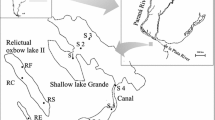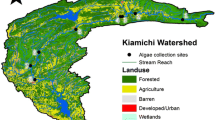Abstract
Data on algal species diversity from six areas along the Swedish coast, differing in salinity, length of growth period and grazing pressure were used to test two main predictions arising from the hump-backed model of species diversity (Grime 1973; Connell & Slatyer 1977; Tilman 1982; Fuentes & Jaksic 1988).
Total number of species per m2, total biomass per m2 and primary production values for each species were calculated for 175 samples. Wave exposure was used as a measure of disturbance. The results are discussed in relation to stress (salinity and light) and disturbance factors (wave effects, ice scouring and grazing).
A hump-backed model of species diversity, in relation to biomass per m2 was found for all investigated areas. A similar response was also observed along local exposure gradients, with higher biomass and lower species numbers found at the sheltered sites compared to the more exposed ones. The most diverse communities were found at sites with intermediate wave exposure and in communities composed of species with intermediate primary production.
It is suggested that the frequency of physical disturbance and severeness of stress strongly affects algal diversity and competition by determining the time interval over which successional replacement of species can occur. This lends support to the non-equilibrium view of community structure giving rise to humpbacked species diversity curves.
Similar content being viewed by others
References
Al-MuftiM. M., SydesC. L., FurnessS. B., GrimeJ. P., & BandS. R. 1977. A quantitative analysis of shoot phenology and dominance in herbaceous vegetation. J. Ecol. 65: 759–791.
AgubovR. 1982. Species diversity and phasing of disturbance. Ecology 63: 289–293.
BarkoI. W. & SmartR. M. 1981. Comparative influences of light and temperature on the growth and metabolism of selected submerged macrophytes. Ecol. Monogr. 51: 219–235.
ConnellJ. H. 1978. Diversity in tropical rain forests and coral reefs. Science 199: 1302–1310.
ConnellJ. H. & SlatyerR. O. 1977. Mechanisms of succession in natural communities and their roles in community stability and organization. Am. Nat. 111: 1119–1144.
DavisA. N. & WilceR. T. 1987. Algal diversity in relation to physical disturbance: a mosaic of successional stages in a subtidal cobble habitat. Mar. Ecol. Prog. Ser. 37: 229–237.
DayR. T. KeddyP. A. & McNeillJ. 1988. Fertility and disturbance gradients: a summary model for riverine marsh vegetation. Ecology 64: 1044–1054.
DaytonP. K. 1971. Competition, disturbance, and community organization: the provision and subsequent utilization of space in a rocky intertidal community. Ecol. Monogr. 41: 351–389.
DaytonP. K. 1975. Experimental evaluation of ecological dominance in a rocky intertidal algal community. Ecol. Monogr. 45: 137–159.
DugginsD. O. 1980. Kelp beds and sea otters: an experimental approach. Ecology 61: 447–453.
FuentesE. R. & JaksicF. M. 1988. The hump-backed species diversity curve: why has it not been found among land animals? Oikos 53: 139–143.
GrimeJ. P. 1973. Control of species density in herbaceous vegetation. J. Environ. Manage. 1: 151–167.
GrimeJ. P. 1979. Plant strategies and vegetation processes. J. Wiley & Sons, Chichester.
Harper, J. L. 1969. The role of predation in vegetational diversity. In: Woodwell, G. M. (ed.), Diversity and stability in ecological systems. Brookhaven Symp. Biol. 22: 48–62.
HurlbertS. H. 1971. The non-concept of species diversity, a critique and alternative parameters. Ecology 56: 496–498.
HustonM. A. 1979. A general hypothesis of species diversity. Am. Nat. 113: 81–101.
HustonM. A. 1985. Patterns of species diversity on coral reefs. Ann. Rev. Ecol. Syst. 16: 149–177.
HåkanssonL. 1981. A manual of lake morphometry. Springer, Heidelberg.
JanssonA.-M. & KautskyN. 1977. Quantitative survey of hard bottom communities in a Baltic archipelago. In: KeeganB. F., CeidighP. O. & BoadenP. J. S. (eds), Biology of benthic organisms, pp. 359–366. Pergamon Press, New York.
JernacoffP. 1985. Factors affecting the recruitment of algae in a midshore region dominated by barnacles. J. Exp. Mar. Biol. Ecol. 67: 17–31.
KautskyH. 1983. Inventering av de grunda vegetations-täckta bottnarna inom det planerade marina naturreservatet Holmöarna, Norra Kvarken, september 1982. Report Länsst. Västerbottens Län, SNV., Askö Lab., Stockholm, 48 pp.
KautskyL. 1988. Life-strategies of aquatic soft bottom macrophytes. Oikos 35: 126–135.
KautskyH., WidbomB. & WulffF. 1981. Vegetation, macrofauna and benthic meiofauna in the phytal zone of the archipelago of Luleå — Bothnian Bay. Ophelia 20: 53–77.
Kautsky, N., Kautsky, U., Jansson, B.-O. & Jansson, P. 1983. Marin inventering av bottenfauna och flora i fågel-och sälskyddsområdena vid Källskären och Vattungarna, Oxelösunds kommun, augusti 1982. Report Askö Lab. Univ. Stockholm, 39 pp.
Kautsky, H., Kautsky, U. & Nellbring, S. 1989. Distribution of flora and fauna in an area receiving pulp mill effluents in the Baltic Sea. Ophelia 28 (in press).
KeddyP. A. 1983. Shoreline vegetation in Axe Lake, Ontario: Effects of exposure on zonation patterns. Ecology 64: 331–344.
LubchencoJ. 1978. Plant species diversity in a marine intertidal algal community: importance of food preference and algal competitive abilities. Am. Nat. 112: 23–39.
LubchencoJ. & GainesS. D. 1981. A unified approach to marine plant-herbivore interactions. I. Populations and communities. Ann. Rev. Ecol. Syst. 12: 405–437.
NavehZ. & WhittakerR. H. 1979. Structural and floristic diversity of shrublands and woodlands in northern Israel and other Mediterranean areas. Vegetatio 41: 171–190.
OsmanR. W. 1977. The establishment and development of a marine epifaunal community. Ecol. Monogr. 47: 37–63.
PaineR. T. 1966. Food web complexity and species diversity. Amer. Nat. 100: 65–75.
PaineR. T. & VadasR. L. 1969. The effect of grazing by sea urchins Strongylocentrotus spp. on benthic algal populations. Limnol. Oceanogr. 14: 710–719.
PaineR. T. & LevinS. A. 1981. Intertidal landscapes: disturbance and the dynamics of pattern. Ecol. Monogr. 51: 145–178.
PeetR. K., Glenn-LewinD. C. & WolfJ. W. 1983. Prediction of man's impact on plant species diversity; A challenge for vegetation science. In: HolznerW., WergerM. J. A. & IkusimaI. (eds), Man's impact on vegetation. Junk, The Hague.
SousaW. P. 1977. Disturbance in marine intertidal boulder fields: the non equilibrium maintenance of species diversity. Ecology 60: 1225–1239.
SousaW. P. 1979. Experimental investigations of disturbance and ecological succession in a rocky intertidal algal community. Ecol. Monogr. 49: 227–254.
SousaW. P. 1980. The response of a community to disturbance: The importance of successional age and species' life histories. Oecologia 45: 72–81.
SousaW. P. 1984. The role of disturbance in natural communities. Ann. Rev. Ecol. Syst. 15: 353–391.
TilmanD. 1982. Resource competition and community structure. Princeton University Press, Princeton NJ.
WaernM. 1952. Rocky-shore algae in the Öregrund archipelago. Acta Phytogeogr. Suec. 30: 1–298.
WallentinusI. 1979. Environmental influence on benthic macrovegetation in the Trosa-Askö area, northern Baltic proper. II. The ecology of macroalgae and submersed phanerogams. Contrib. Askö Lab. Univ. Stockholm 25: 1–210.
WetheyD. S. 1985. Catastrophe, extinction, and species diversity: a rocky intertidal example. Ecology 66: 445–456.
WilsonS. D. & KeddyP. A. 1986. Measuring diffuse competition along an environmental gradient: results from a shoreline plant community. Am. Nat. 127: 862–869.
ZeevalkingJ. I. & FrescoL. F. M. 1977. Rabbit grazing and species diversity in a dune area. Vegetatio 35: 193–196.
Author information
Authors and Affiliations
Rights and permissions
About this article
Cite this article
Kautsky, L., Kautsky, H. Algal species diversity and dominance along gradients of stress and disturbance in marine environments. Vegetatio 83, 259–267 (1989). https://doi.org/10.1007/BF00031698
Accepted:
Issue Date:
DOI: https://doi.org/10.1007/BF00031698




